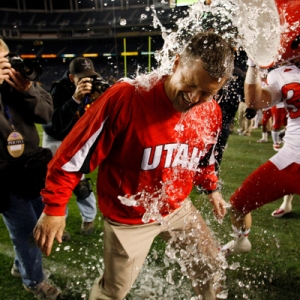Impact of Pac-10 Realignment
by Trevor Whenham - 7/1/2010
![]()

The biggest story coming out of the college football realignment frenzy when it comes to the Pac-10 is the conference’s failure to pull off the incredibly ambitious bid to form the Pac-16. They fell well short of the goal, and you could argue that they were masterfully used by Texas to get what they wanted and increase their own stature. The story that doesn’t get as much national coverage, though, is the impact that the changes the conference did make will have. By adding two teams the conference has fundamentally impacted things that will affect the teams, fans, and bettors for years to come. Here’s a look at four of the biggest impacts - positive and negative - that the growth will have:
Utah
The biggest winner in all of the changes - in any conference - is Utah. They have gone from a good team in a respected fringe conference to a potentially very good team in a major conference - one which, most importantly, has an automatic bid to the BCS - with this one move.
Utah has been good for a while now, and was great last year, despite having a lot working against them. They haven’t been able to recruit at a nationally competitive level, and they have been seen as a stepping stone instead of an ultimate destination for coaches. That all changed as soon as they made the move.
Recruits that would have no interest in playing in the Mountain West won’t have that issue at all about playing in the Pac-10. More significantly, the team has a chance not only to be a major conference team, but a very good major conference team.
The Pac-10 isn’t in a position of massive strength right now, and the woes at USC won’t help that. As they currently are, the Utes are already one of the three or four best teams in the conference and that’s with a recruiting handicap. there’s no reason that this team can’t be an elite member of the conference in a few years - perhaps as soon as 2011 when they join the conference.
They’ll also be able to keep coaches around - Kyle Whittingham won’t be tempted by a BCS conference job as quickly because all of a sudden he already has one - and they can attract top-level coaches when they do need to find a new one. there is the odd disadvantage - like not playing the Holy War against BYU as often - but the net impact of this move is overwhelmingly positive for the Utes.
Colorado
I can’t get nearly as excited about Colorado’s move as I can about Utah’s. The Buffaloes have made essentially a lateral move - from one conference that doesn’t get the respect of the SEC or the Big Ten to another.
The best thing about this move, though, is that there is a chance that they will fit in in their new surroundings better than they have in the old conference. It has been far too long since Colorado was a great team, and they keep falling further and further behind the Big 12 elite every year. That might not change when they move to the Pac-10, but it certainly can’t hurt.
The Pac-10 is probably a bit easier than the Big 12 - especially now that USC is in trouble - and the style of play could be a better fit for Colorado. It will also align them closer to the recruiting markets that they have done better in.
Basement woes
The team that is hurt most by this move is Washington State. For far too long they have been the worst team in a 10-team conference. Now they are going to be the worst team in a 12-team conference. It will be even harder for them to stand out, harder for them to recruit their markets, and harder for them to draw in a coaching staff that can help.
The Cougars haven’t shown a lot of signs of life recently, but they unwittingly took a big step backwards with this move. The only real plus side for them is that their revenue should grow eventually as the conference grows their revenue base.
Divisions
Moving from 10 teams to 12 means two big things for the conference - the formation of two divisions, and the playing of a conference championship game. The championship game makes it harder for a top team to remain unscathed, and is a big test for teams.
The bigger change, though, is the divisions. Forming divisions always creates problems - competitive imbalance and so on - but those problems could be more acute in this conference.
The epicenter of the Pac-10 is L.A. That’s where the biggest population is, so it’s where the most recruits are. It’s also where all the glamor is, so it’s where players want to play. USC and UCLA will likely be in the same division, so that means that only four other teams will get to be in a division with them. That means that only those four teams will get a chance to play in L.A. almost every year. Teams that aren’t in that division are going to be at a recruiting disadvantage.
Most Recent College Football Handicapping
- 2025 College Football National Championship Futures Odds with Expert Betting Predictions
- College Football Playoff Semifinals Betting Props and Predictions
- College Football Playoff Analytical Report
- College Football Playoff Prop Bet Predictions for First Round
- Bowl Game Schedule - College Football Bowl Schedules for 2024-25
- 2024-25 Heisman Trophy Predictions with Betting Odds
- College Football Playoff: Odds and Best Bets to Make 12-Team Field
- College Football Predictions: Week 10 Opening Line Report and Picks
- College Football Predictions: Week 9 Opening Line Report and Picks
- College Football Predictions: Week 8 Opening Line Report and Picks
